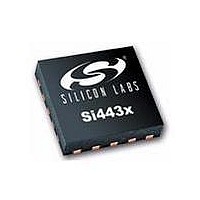SI4431-B1-FM Silicon Laboratories Inc, SI4431-B1-FM Datasheet - Page 56

SI4431-B1-FM
Manufacturer Part Number
SI4431-B1-FM
Description
IC TXRX 240-930MHZ -8-13DB 20QFN
Manufacturer
Silicon Laboratories Inc
Specifications of SI4431-B1-FM
Package / Case
20-VQFN
Mfg Application Notes
Transitioning SI4430/31 to Rev B
Frequency
240MHz ~ 930MHz
Data Rate - Maximum
256kbps
Modulation Or Protocol
FSK, GFSK, OOK
Applications
General Purpose
Power - Output
13dBm
Sensitivity
-121dBm
Voltage - Supply
1.8 V ~ 3.6 V
Current - Receiving
18.5mA
Current - Transmitting
30mA
Data Interface
PCB, Surface Mount
Antenna Connector
PCB, Surface Mount
Operating Temperature
-40°C ~ 85°C
Wireless Frequency
240 MHz to 930 MHz
Output Power
13 dBm
Operating Supply Voltage
1.8 V to 3.6 V
Maximum Operating Temperature
+ 85 C
Mounting Style
SMD/SMT
Maximum Supply Current
30 mA
Minimum Operating Temperature
- 40 C
Modulation
FSK, GFSK, OOK
Operating Temperature (min)
-40C
Operating Temperature (max)
85C
Operating Temperature Classification
Industrial
Product Depth (mm)
4mm
Product Length (mm)
4mm
Operating Supply Voltage (min)
1.8V
Operating Supply Voltage (typ)
3V
Operating Supply Voltage (max)
3.6V
Lead Free Status / RoHS Status
Lead free / RoHS Compliant
Memory Size
-
Lead Free Status / Rohs Status
Lead free / RoHS Compliant
Available stocks
Company
Part Number
Manufacturer
Quantity
Price
Company:
Part Number:
SI4431-B1-FMR
Manufacturer:
TE
Quantity:
2 000
Part Number:
SI4431-B1-FMR
Manufacturer:
SILICON LABS/èٹ¯ç§‘
Quantity:
20 000
Si4430/31/32-B1
8.6. Wake-Up Timer and 32 kHz Clock Source
The chip contains an integrated wake-up timer which can be used to periodically wake the chip from SLEEP mode.
The wake-up timer runs from the internal 32.768 kHz RC Oscillator. The wake-up timer can be configured to run
when in SLEEP mode. If enwt = 1 in "Register 07h. Operating Mode and Function Control 1" when entering SLEEP
mode, the wake-up timer will count for a time specified defined in Registers 14–16h, "Wake Up Timer Period." At
the expiration of this period an interrupt will be generated on the nIRQ pin if this interrupt is enabled. The
microcontroller will then need to verify the interrupt by reading the Registers 03h–04h, "Interrupt Status 1 & 2". The
wake-up timer value may be read at any time by the wtv[15:0] read only registers 17h–18h.
The formula for calculating the Wake-Up Period is the following:
Use of the D variable in the formula is only necessary if finer resolution is required than can be achieved by using
the R value.
There are two different methods for utilizing the wake-up timer (WUT) depending on if the WUT interrupt is enabled
in “Register 06h. Interrupt Enable 2.” If the WUT interrupt is enabled then nIRQ pin will go low when the timer
expires. The chip will also change state so that the 30 MHz XTAL is enabled so that the microcontroller clock
output is available for the microcontroller to use to process the interrupt. The other method of use is to not enable
the WUT interrupt and use the WUT GPIO setting. In this mode of operation the chip will not change state until
commanded by the microcontroller. The different modes of operating the WUT and the current consumption
impacts are demonstrated in Figure 29.
A 32 kHz XTAL may also be used for better timing accuracy. By setting the x32 ksel bit in Register 07h "Operating
& Function Control 1", GPIO0 is automatically reconfigured so that an external 32 kHz XTAL may be connected to
this pin. In this mode, the GPIO0 is extremely sensitive to parasitic capacitance, so only the XTAL should be
connected to this pin with the XTAL physically located as close to the pin as possible. Once the x32 ksel bit is set,
all internal functions such as WUT, micro-controller clock, and LDC mode will use the 32 kHz XTAL and not the
32 kHz RC oscillator.
The 32 kHz XTAL accuracy is comprised of both the XTAL parameters and the internal circuit. The XTAL accuracy
can be defined as the XTAL initial error + XTAL aging + XTAL temperature drift + detuning from the internal
oscillator circuit. The error caused by the internal circuit is typically less than 10 ppm.
56
Add R/W Function/Description
14
15
16
17
18
R/W
R/W
R/W
R
R
Wake-Up Timer Period 1
Wake-Up Timer Period 2 wtm[15] wtm[14] wtm[13] wtm[12] wtm[11] wtm[10] wtm[9] wtm[8]
Wake-Up Timer Period 3
Wake-Up Timer Value 1
Wake-Up Timer Value 2
wtv[15] wtv[14] wtv[13] wtv[12] wtv[11]
wtm[7]
WUT Register
wtv[7]
D7
wtm[15:0]
wtr[4:0]
WUT
wtm[6]
wtv[6]
D6
Rev 1.1
4
wtm[5]
32
wtv[5]
M Value in Formula
D5
R Value in Formula
M
.
768
Description
2
wtm[4]
wtv[4]
wtr[4]
R
D4
ms
wtm[3]
wtv[3]
wtr[3]
D3
wtv[10]
wtm[2]
wtv[2]
wtr[2]
D2
wtm[1] wtm[0]
wtv[9]
wtv[1]
wtr[1]
D1
wtv[8]
wtv[0]
wtr[0]
D0
POR Def.
03h
00h
00h
—
—












